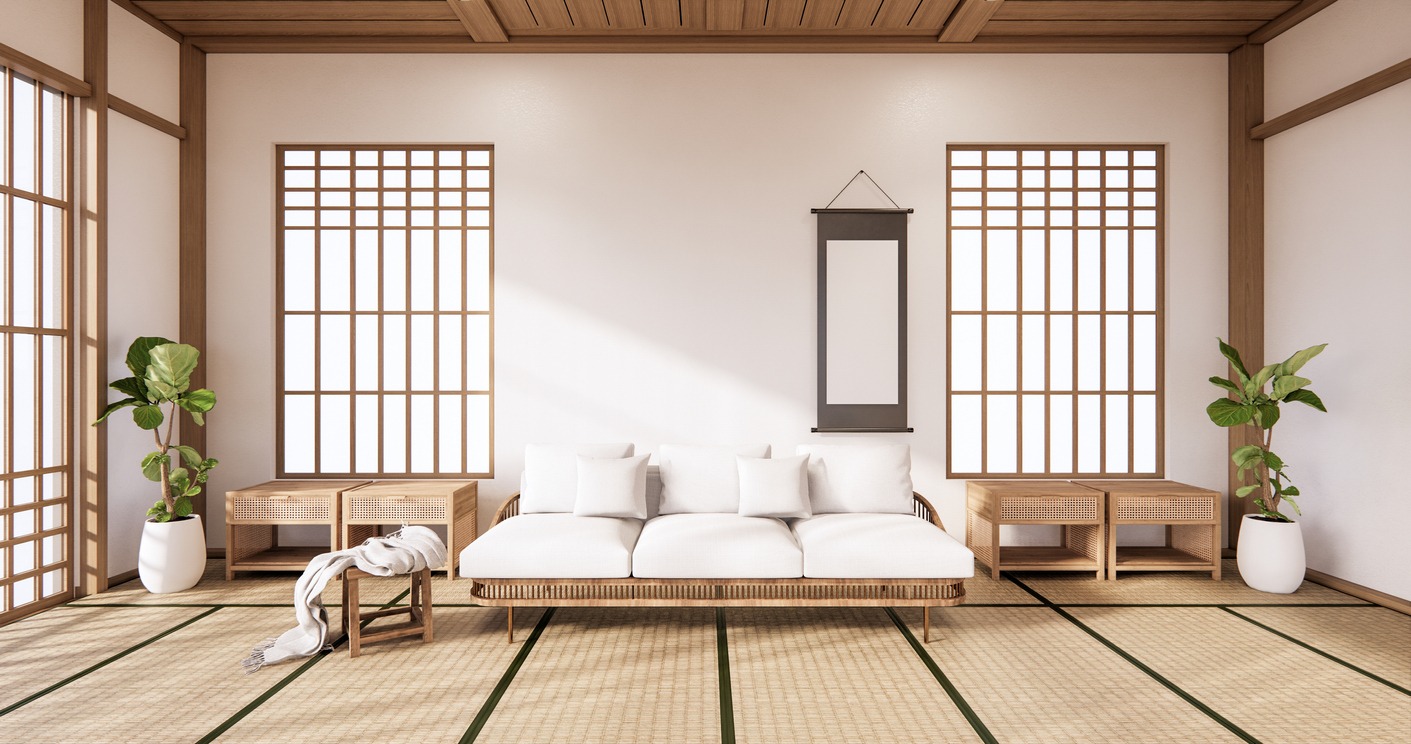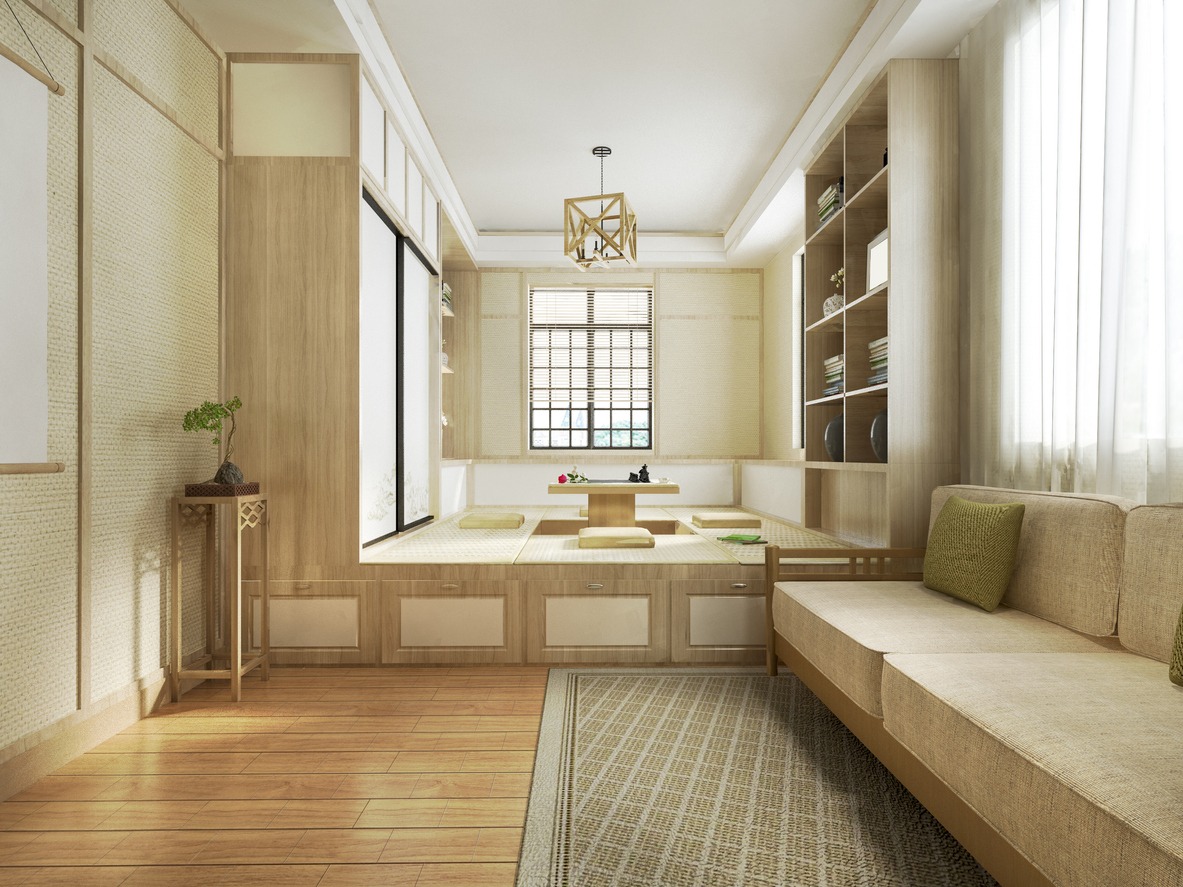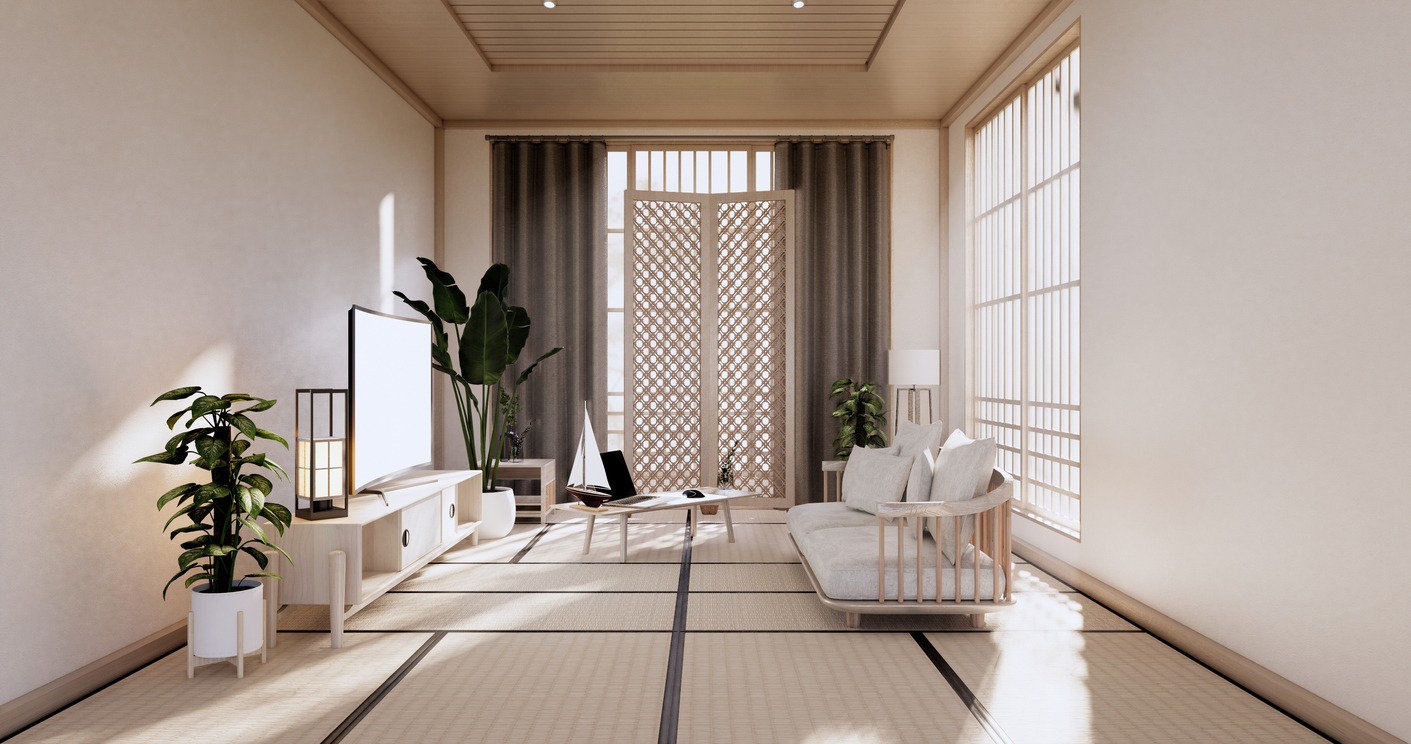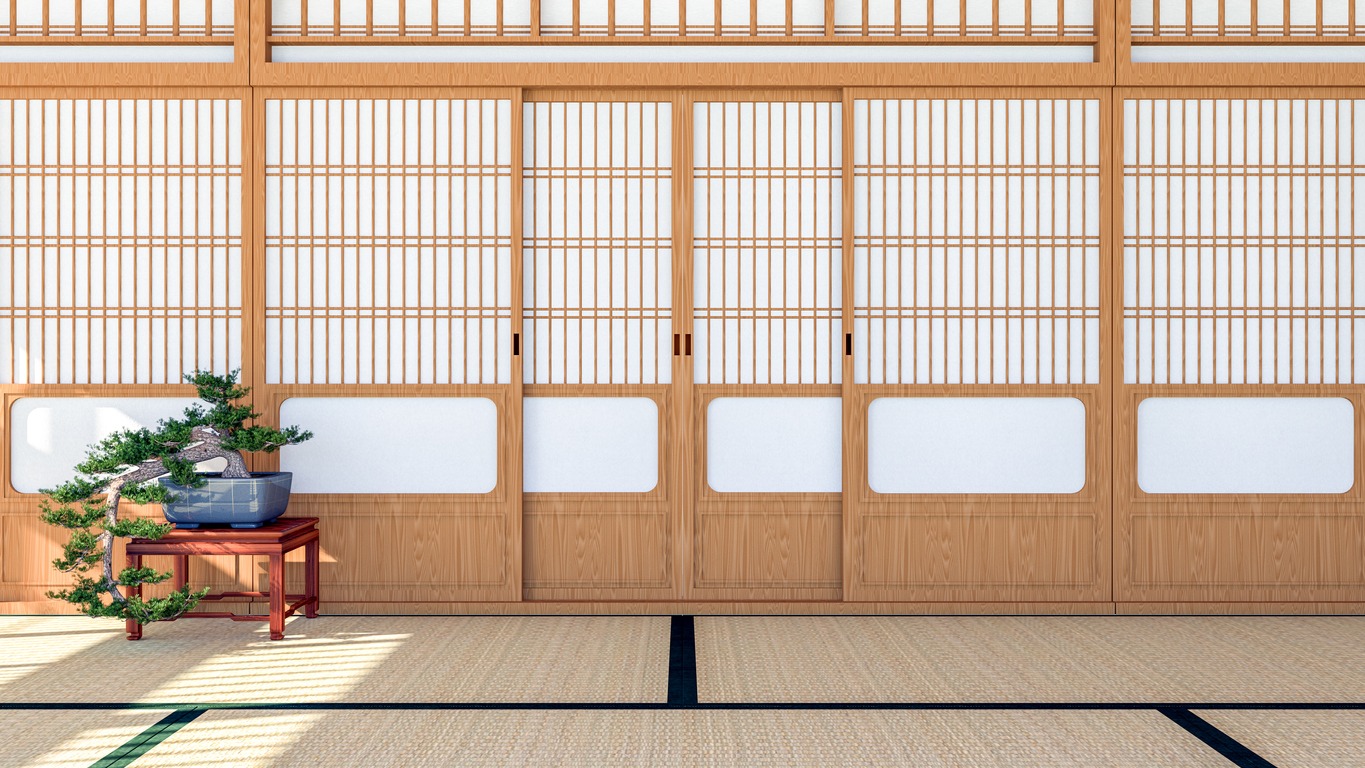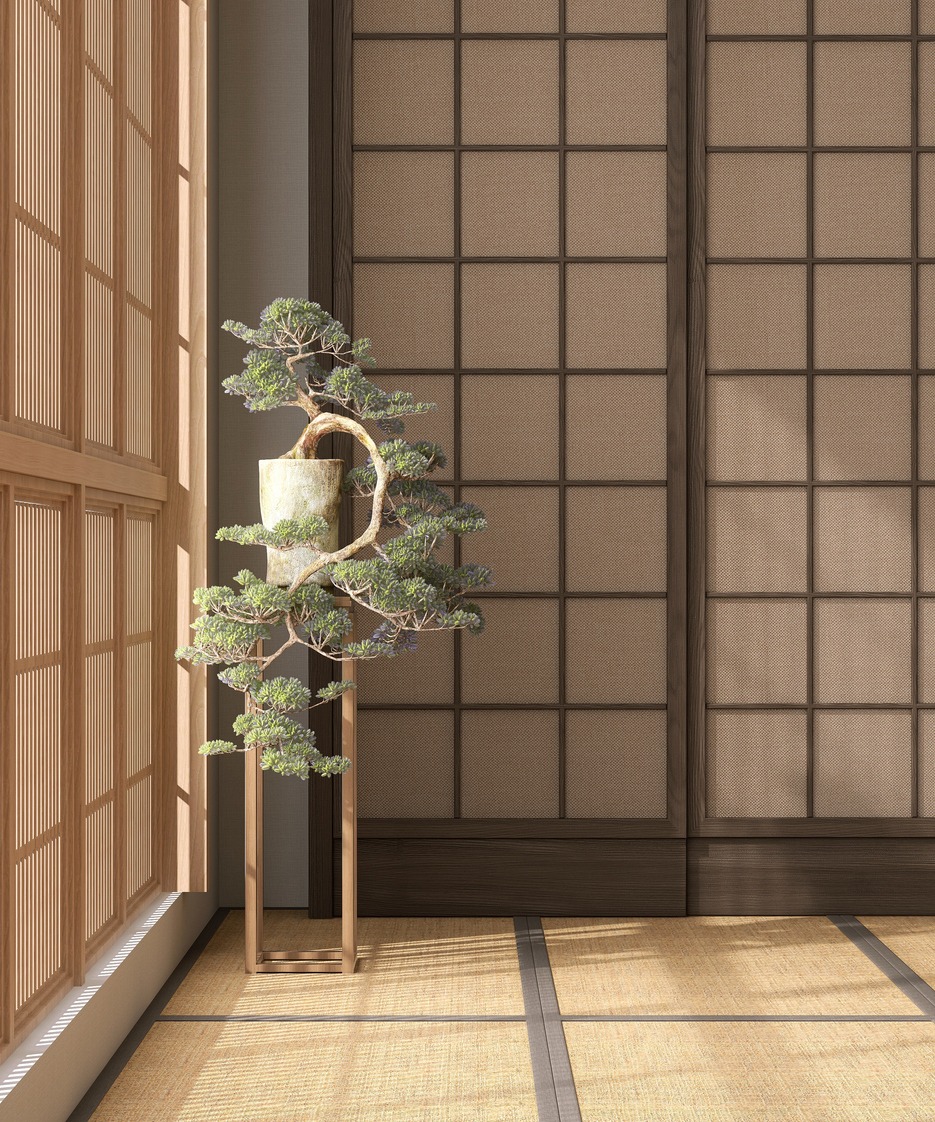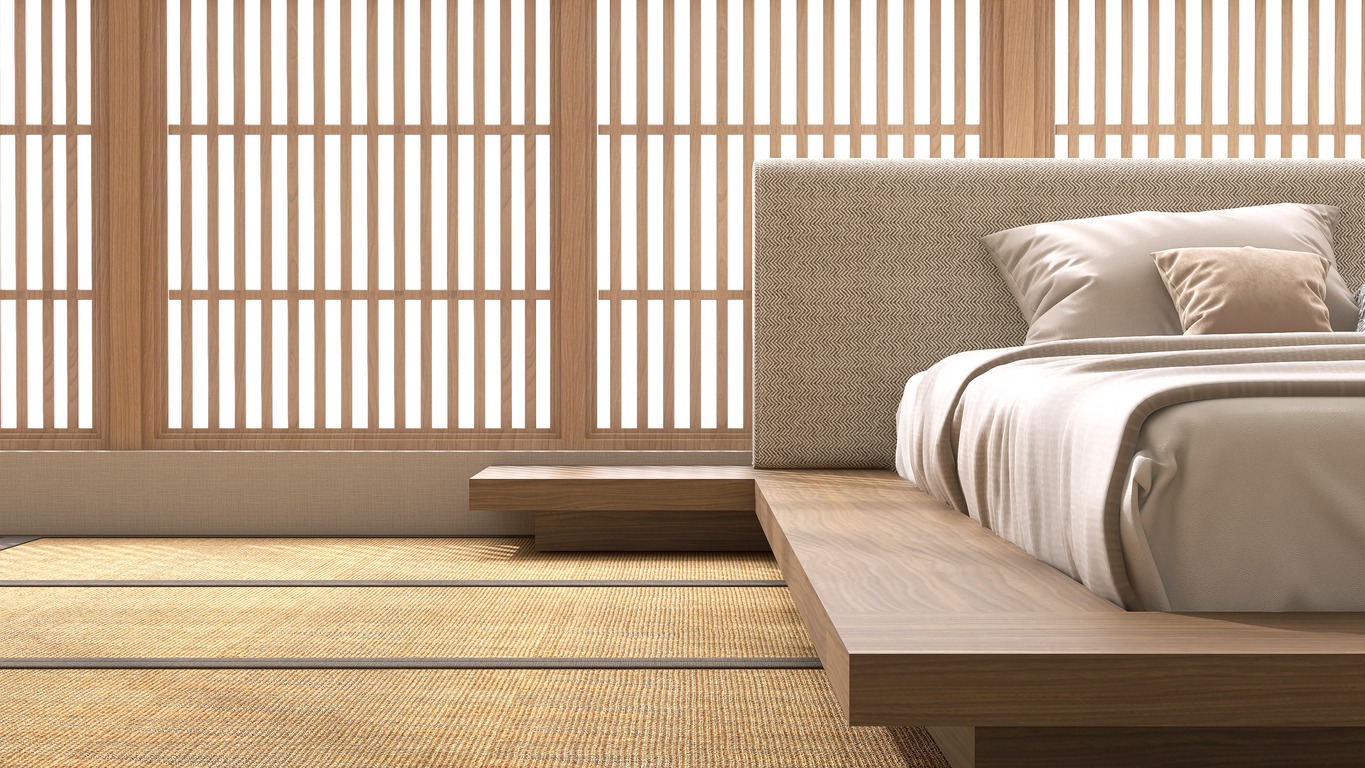Japanese design is rooted in simplicity, featuring clean lines, natural textures, a neutral color palette, and minimalistic styling. These design principles encourage minimalism, decluttering, and functionality without sacrificing aesthetics. Whether you’re seeking space efficiency, a Zen ambiance, or contemporary interiors, this article provides tips and ideas to infuse Japanese design features into your home.
Embrace Natural Elements and Textures
Japanese design prefers natural materials. To infuse your home with Japanese wood aesthetics, consider incorporating it into your flooring or adding shoji screens for a simple yet effective touch.
To capture the calmness of Japanese interiors, opt for a simple palette of natural materials like stone, wood, and bamboo.
Wood is particularly essential, as it’s traditionally used with a subdued color palette. Wooden flooring is commonly used in hallways, utilizing Japan’s native wood varieties. It’s good to choose bright, natural woods like birch or white oak that show the grain. This material is often used to cover both ceilings and floors, creating a tactile and soothing atmosphere. Wooden paneling is often used on walls and ceilings and is sometimes adorned with inscriptions and designs to add a touch of color.
Bamboo, on the other hand, has a natural and earthy appearance that complements the emphasis on light. When using wood and bamboo in your home, choose pieces with a light color palette. This aligns perfectly with the concept of not overwhelming the space and helps reflect natural light throughout your interior.
Embrace a Neutral Color Palette
Japanese homes draw from the natural world for their color palettes, primarily using shades of brown, green, and gray. These hues evoke a deep sense of tranquility. If you want to decorate the Japanese way, incorporate earthy tones into different aspects of your interior, such as gray floor tiles, brown wooden shelving, or the presence of green houseplants.
For walls, consider white or light beige plaster to create a serene ambiance. Rather than using pure white, nuanced and textured Japanese plaster is favored. These colors may even have hints of brown to harmonize with the flooring.
Carpets are a common sight in Japanese rooms, either covering the entire floor or in smaller sections for seating. These carpets are intentionally uncomplicated, featuring a single color and minimalistic designs, aligning with the Japanese penchant for simplicity and nature.
Blend Indoor and Outdoor Spaces
Japanese architecture is renowned for seamlessly merging indoor and outdoor areas. In Japanese design, green garden views are treated as dynamic pieces of art. Achieve this by installing expansive floor-to-ceiling windows and sliding doors that open up to your garden, allowing fresh air to flow in. By using more windows that give the view of the outdoors, you can take a moment to relax and appreciate the beauty of nature indoors.
Modern homes are increasingly adopting sliding doors and screens, reflecting the Zen philosophy. These additions are not only practical but also subtly enhance a space without overwhelming it. They maintain the Japanese principles of simplicity and humility in design.
Embrace Minimalism
Minimalism is a hallmark of Japanese design and architecture. It’s both an aesthetic choice and a functional one. Traditional Japanese homes are sparsely furnished, featuring items like low-height tables with floor mats and futon mattresses for sleeping. Every element in a minimalist space should serve a purpose, leaving no room for clutter. You might explore Feng Shui principles to understand how this style of interior design can work for you. In Japanese interior design, less truly means more.
A minimalist approach to styling is all about creating a sense of freedom and openness, fostering a desired mental state within your home. It’s a movement that’s gained considerable popularity, paying homage to the foundational principles of Japanese design. Opt for wooden furniture with clean lines, as natural materials embody simple beauty. Choose a decor with uncomplicated designs, like plain vases that showcase the beauty of flowers.
If you don’t know where to start, you can begin by decluttering. Follow the wisdom of Marie Kondo by organizing and decluttering your closets, drawers, and other spaces where mess accumulates. Decluttering can be transformative – it can make you realize that you can live simply and that a lot of your stuff doesn’t truly matter.
Opt for Sliding Doors or Screens
Traditional Japanese screens, known as ‘shoji,’ offer the flexibility to partition a room as desired. They come in various materials, from delicate paper to contemporary glass. The emphasis is on allowing light to pass through, keeping the space airy and bright.
You can also use another form of sliding panels called fusuma. It differs from Shoji in that they are sturdier and less translucent. They may feature artistic elements like trees or dragons and serve as doors, walls, and decorative pieces in the home.
Add Some Hallways
Traditional Japanese houses come with engawa, or the outdoor corridor encircling the house. Historically, it was used to create space between delicate Shoji panels and rain. While not present in all traditional Japanese homes, it’s a feature more commonly found in upscale residences.
To mimic the Japanese style, you can install narrow hallways with wooden flooring near the gardens. This design allows you to effortlessly slide open the door of your room and be greeted by the garden view.
During the evening, it’s a common practice for Japanese people to sit along these hallways, enjoying the tranquility of the garden and its greenery. On higher floors, these hallways often feature large windows for ventilation and scenic views of the garden.
Embrace Natural Lighting
Japanese culture puts great importance on the art of illuminating a home with natural light. This connection to nature and a minimalist lifestyle influences the use of daylight in Japanese design. To brighten your space, consider incorporating large windows that allow abundant natural light. Opt for window treatments like bamboo shades or light curtain panels to ensure that you don’t obstruct the flow of natural light.
Incorporate Paper Screening
Japanese craftsmanship extends to paper arts, including the use of paper screening on large windows. In some living rooms, paper screens are employed as partitions to maintain privacy while still allowing sunlight to filter through gently, in alignment with Japanese preferences.
The Japanese also love to use byobu, or folding screens used as room dividers or decorative partitions. These screens are adorned with beautiful artwork, such as decorative paintings or calligraphy, and can be folded up when not in use.
Embrace Modular Design
Modular design is a fundamental aspect of Japanese home design. It allows various components, from furniture to entire spaces, to be connected, reconfigured, or repurposed for multiple uses, maximizing available space.
For instance, bamboo panels can be used to divide a spacious room into smaller functional areas. One part can serve as a bedroom while the other transforms into a workspace. Alternatively, a living room can easily be converted into a bedroom at night using a sleeper sofa.
Infuse Japanese greenery
Japanese culture has a strong connection with nature, and you can bring this essence by adding greenery to your home. Whether through elegant flower arrangements, eco-friendly furniture, or sliding doors that open up to natural vistas, the connection with nature is unmistakable.
Alongside traditional greenery, consider incorporating classic Japanese plants like bonsai and bamboo. Opt for plants with large, lush leaves, such as palm and orchids. Additionally, having large windows lets you be close to nature and enjoy the natural surroundings. Create vertical gardens indoors or on your veranda, suitable for plants like orchids and bromeliads that can be suspended from above.
Embrace Tatami Floors
Tatami floors are a quintessential feature in Japanese homes. These natural mats, traditionally made from rice straw, are placed over standard carpeted flooring in rooms. They add a warm and inviting feel to the space, making it conducive to sitting and relaxing. They also have a distinct aroma, especially when new. It’s important to keep them dry, as they are highly absorbent and prone to molding. To know more about sliding doors, tatami floors, and other features of a traditional Japanese Home, check out our Interesting Facts about Japanese Houses.
Use Versatile Furniture
In Japanese homes, you’ll often find multipurpose furnishings. Since many homes lack dedicated rooms for specific purposes, versatile furniture is essential. For example, sitting on large cushions on the floor is a common practice instead of having multiple armchairs cluttering the space. If you prefer not to sit on the floor, low-to-the-ground furnishings are a great way to achieve the Japanese aesthetic.
As you pick a versatile furniture, make sure the color palette and materials are consistent with one another. By coordinating tones and textures, you achieve visual harmony.
Add Some Thoughtful Decoration
While minimalism promotes a clutter-free space, a home can sometimes feel austere without a few well-chosen accessories. In Japanese interior design, decorations hold symbolic significance and are thoughtfully placed, not randomly scattered.
Traditional Japanese rooms feature a special alcove called the tokonoma, reserved for a hanging scroll (kakejiku) or ikebana flowers. Paintings and decorations are rarely hung on other walls but are kept within the alcove. You may choose to incorporate traditional Japanese cultural elements, such as bonsai trees or calligraphy artwork.
Keep the walls simple and reserve the space for something unique. Consider adding a symbolic ichirin-zashi (single flower arrangement) or an art panel to a spacious, empty wall. You may also want to add Katana swords or traditional lanterns such as toro. Symbolically decorating with pieces from your favorite artisan can enhance your lifestyle.
Design an Entryway with Genyen and a Small Tea Room
In Japanese homes, the entryway, known as Genyen, serves as an essential feature. As you step inside, the first order of business is to remove your shoes and neatly place them in a shoe rack or a small locker designed to accommodate various types of footwear. Shoes are never worn inside the house in Japanese culture, so creating a Japanese-style entryway requires a designated space for shoe storage. Keep this area clean and uncluttered, avoiding excessive furniture. Additionally, some homes feature a small tea room adjacent to the entryway, enhancing the traditional Japanese ambiance.
Incorporate Washi Paper and Room Dividers
To create a cozy and inviting atmosphere in bedrooms, consider using handcrafted washi paper crafted by skilled artisans. This textured material can help DD have a soothing ambiance, especially when combined with natural wood, lanterns, and crisp white bedding. You can apply washi paper to doors and walls to infuse a calming effect. Doors adorned with Japanese washi paper or crafted with Kumiko woodworking techniques become artistic elements seamlessly integrated into the architecture while maintaining a clean and simple space.
Design Your Kitchen the Japanese Way
Japanese kitchens come with unique features that set them apart from traditional kitchens. For instance, they often include a fish grilling machine located beneath the stove, allowing for direct grilling without the need for an additional appliance. Instead of conventional stoves, electric or manganite stoves are typically built into the countertops. Additionally, Japanese kitchens may feature hidden storage beneath the floor, accessible through a small cutout in the kitchen floor itself.
Have a Separate Laundry Room
Japanese households commonly have a dedicated laundry room to prevent dirt from entering the main living spaces. Laundry rooms are kept separate from bathrooms, reflecting a preference for cleanliness and organization. This approach allows for clean and neatly dried clothes to be conveniently stored in one place within the laundry room, aligning with the Japanese commitment to cleanliness and orderliness.
Infuse Natural Fragrances and Scents
As lovers of natural flowers and greenery, Japanese homes often feature natural fragrances, particularly in areas like bathrooms, creating a spa-like atmosphere that feels refreshing and divine. This commitment to natural scents is a staple of Japanese homes, with the aroma of their gardens permeating the living space, enhancing the overall ambiance.
Create a Meditation Oasis
When you’re in a peaceful state of mind, the last thing you want is to face the chaos of your kitchen or the noise of your children while playing. Why not add a meditation space in your house? It doesn’t have to be a whole room – it can be a simple, serene spot in your house where you can read a book or enjoy a cup of tea in peace. To enhance the calming ambiance, fill the space with natural light, green plants, and perhaps a water feature.
Install Soak Tubs
The gentle sound of flowing water has a calming effect, mirroring the importance of water in Japanese interior design, which draws inspiration from nature. Japanese-style bathtubs are gaining popularity worldwide for their ability to provide a Zen-like experience. These deep tubs often come with built-in seating, allowing you to sit comfortably while surrounded by soothing waters.
Commonly known as ofuro, Japanese soaking tubs are very beneficial. They are deeper than typical western bathtubs and are housed in wood but also in acrylic and polyester. They are also ergonomically designed for support and relaxation. Plus, it can be a unique design feature to add to your bathroom.
Opt for a Low Bed
To infuse Japanese-style elements into your bedroom, consider choosing a low bed. This design choice echoes the traditional futon beds used in Japan, which are thin mattresses placed directly on the floor without a frame. If you prefer some elevation, you can opt for a low-standing bed frame. This not only creates a sense of spaciousness but also aligns with the understated and humble nature of Japanese-inspired interior design.
Bottom Line
You can bring a touch of Japanese style into your home by embracing their culture, discipline, and habits. These elements infuse freshness and cleanliness into their homes. Even in modern Japanese houses, these fundamental principles serve as a foundation for their designs. Use natural colors on your walls, incorporate raw and natural furniture, and consider adding antique decorative items. The key is to maintain a natural, clean, and green ambiance.
